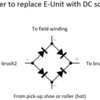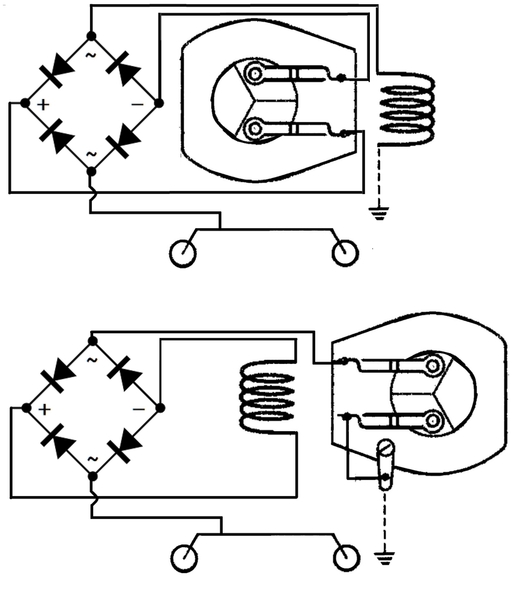I am looking for some electrical expertise. When Frank Ellison built his Delta Lines in the 1940 timeframe, he had a number of Lionel AC locomotives (scale Hudsons and the Union Pacific M10000 streamliner among them) with E unit reversing. He went to DC power for the Delta Lines and used Mallory 1-B-8-C-1 rectifiers to replace the E units (to keep the AC motors and be able to reverse them). I haven't been able to find any information on this rectifier (it was over eighty years ago) but I am wondering if it was what we now call a bridge rectifier hooked up per the attached diagram:
Replies sorted oldest to newest
Thank you both, Rob and John.
I imagine the rectifier was selenium which was bulky especially for higher amperage. Curious if the rectifier was placed in tender (whistle would be sacrificed?).
Comments?
@rrman posted:Curious if the rectifier was placed in tender (whistle would be sacrificed?).
Well, not really "sacrificed", that ship sailed with the decision to run on DC which rendered the remote whistle feature inoperative already.
@rrman posted:I imagine the rectifier was selenium which was bulky especially for higher amperage. Curious if the rectifier was placed in tender (whistle would be sacrificed?).
Comments?
In Frank Ellison's words, "They're a little large, but they have ample capacity and work perfectly." (From "Delta Lines" in the August 1941 issue of The Model Railroader magazine.) He seemed very happy to find such an elegant solution to the problem.
Ellison attributed the "suggestion" to use this solution to Frank Arnaud of Milwaukee. He did not say anything about the whistle feature.
I was hoping to find the Mallory 1-B-8-C-1 rectifier in advertisements in the model railroad magazines of the that era but no luck so far. Google search didn't yield anything. The next place to look would be electronics magazines - if they existed back then - or perhaps Mechanix Illustrated, Popular Mechanics, or Popular Science of that era.
For the record books, the bridge circuit is the time honored way to get universal motors to reverse with applied DC polarity. There is another way I used for a short time that works just as well. A DPDT relay which activates only on applied negative DC (diode in series with the relay coil) and which the contacts reverse the field/armature connections. The bridge circuit is neater.
I found a Mallory 1B8R here: https://www.antiqueradios.com/...hp?f=15&t=336750.
The ad below the picture of the rectifier makes it appear that model numbers starting with 1B8 have eight junctions (says the 1B8R has 8 junctions instead of 4 like the 1B4R above). I am wondering about the eight junctions.
@PGentieu posted:I found a Mallory 1B8R here: https://www.antiqueradios.com/...hp?f=15&t=336750.
The ad below the picture of the rectifier makes it appear that model numbers starting with 1B8 have eight junctions (says the 1B8R has 8 junctions instead of 4 like the 1B4R above). I am wondering about the eight junctions.
Although these pictures do not specifically show the Mallory unit, these Ebay pictures will give you an idea of how they looked. Basically square heatsink fins, the higher the amperage, the bigger heatsinks. The seleniums were not terribly efficient and heated up..
The eight lug rectifiers were either connected in parallel to increase amp rating or in series to boost the voltage rating with addition of high resistance resistors to even out voltage drops so one pack was not overloaded.
Oh yeah, forgot to mention, you did not want to be around when they fail. Cross between an outhouse on hot day and worst rotten egg (hot sulfur) smell. When younger, I had a small Lionel HO power pack (red lever that went right or left for train forward reverse.) It suddenly and dramatically failed with smoke and rotten egg. ![]() Couldn't sleep in my room for several days and kept windows open 24/7 until stench abated. Ah the memories.....NOT!!
Couldn't sleep in my room for several days and kept windows open 24/7 until stench abated. Ah the memories.....NOT!!
@rrman posted:Although these pictures do not specifically show the Mallory unit, these Ebay pictures will give you an idea of how they looked. Basically square heatsink fins, the higher the amperage, the bigger heatsinks. The seleniums were not terribly efficient and heated up..
The eight lug rectifiers were either connected in parallel to increase amp rating or in series to boost the voltage rating with addition of high resistance resistors to even out voltage drops so one pack was not overloaded.
Oh yeah, forgot to mention, you did not want to be around when they fail. Cross between an outhouse on hot day and worst rotten egg (hot sulfur) smell. When younger, I had a small Lionel HO power pack (red lever that went right or left for train forward reverse.) It suddenly and dramatically failed with smoke and rotten egg.
Couldn't sleep in my room for several days and kept windows open 24/7 until stench abated. Ah the memories.....NOT!!
Thank you for the explanation of the eight lug rectifiers. That makes sense. However, I am not seeing the eBay pictures.
@PGentieu posted:Thank you for the explanation of the eight lug rectifiers. That makes sense. However, I am not seeing the eBay pictures.
Thats because I forgot to paste in link. Early onset dementia I guess ![]()
If you look through enough back issues of OGR, you'll find detailed information on just about every aspect of the hobby. Sure enough, on pages 37 and 38 of Run 142 from August 1995, there is an article, "AC or DC, Which is better?" by Al Moore which covers this subject. The article includes excellent, clear drawings by the author, one of which is the wiring diagram for using a full-wave bridge rectifier to reverse a universal (AC) motor with DC current. The author goes one step further and shows how to wire a Lionel AC transformer to provide reversible DC current.
This information is readily available through a digital subscription and the online archive "Magazine Digital Library."









